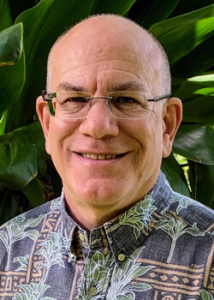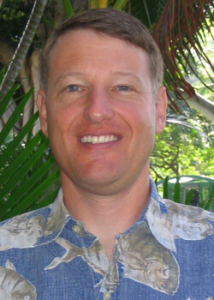
The Regents’ Medal for Excellence in Research is awarded by the University of Hawaiʻi Board of Regents in recognition of scholarly contributions that expand the boundaries of knowledge and enrich the lives of students and the community.
Kenneth C. Chambers

Kenneth C. Chambers is an astronomer at the Institute for Astronomy and principal investigator and founding director of the Panoramic Survey Telescope and Rapid Response System (Pan-STARRS) located on Haleakalā. He and the Pan-STARRS team have had a huge impact on astronomy with discoveries from the solar system to cosmology. These include thousands of near-Earth asteroids, hundreds of Kuiper belt objects, dozens of comets and ʻOumuamua—the first interstellar object scientists have tracked.
By surveying the sky repeatedly, they discovered new classes of super-luminous and under-luminous supernovae, and the first convincing case of a tidally disrupted star spiraling into a supermassive black hole. They also discovered billions of new galaxies providing clues to the large-scale structure of the universe.
Chambers and his team made crucial measurements of the first binary neutron star merger found with gravity waves, contributing proof that these events are the origin of the heavy elements. He has authored 250 publications with 28,000 citations. Chambers is a 1999 recipient of the Regents’ Medal for Excellence in Teaching.
Jeffrey Drazen

Jeffrey Drazen is a professor in the Department of Oceanography in the UH Mānoa School of Ocean and Earth Science and Technology. He joined the UH Mānoa faculty in 2004. Drazen is recognized internationally for his research on food-webs and communities of the open ocean and deep sea, particularly fishes.
His work and that of his students and postdocs has helped elucidate the energetic strategies of deep-sea fishes, identified important pathways in deep-sea food webs and explored the ecology of hadal trenches, the deepest ecosystem on earth. His research has helped evaluate the environmental risks of deep-sea mining, a topic of critical interest as companies and countries look to the ocean to supply battery metals needed for the “green transition.”
Drazen has authored and co-authored more than 130 scientific articles and book chapters, received more than $20 million in research grants and has participated in more than 60 research cruises with more than 1,000 days at sea, often as chief scientist.
Shadia Rifai Habbal

Shadia Rifai Habbal is a professor of astronomy at the Institute for Astronomy. She joined the UH Mānoa faculty in 2005 and is best known for her seminal contributions to the field of solar and heliospheric physics, which encompasses the outer atmosphere of the Sun, the solar corona and its expansion as the solar wind into interplanetary space.
Habbal is recognized for her scientific insight to capitalize on the unique observing opportunities available during total solar eclipses. She established the Solar Wind Sherpas, the largest international team to carry out eclipse observations. She and her team have made game changing discoveries by unraveling the solar wind that originates throughout the corona from sources at 1.2 million degrees. The processes that control that temperature remain unknown.
These observations are enabling the identification of processes responsible for the corona reaching temperatures at least three orders of magnitude larger than that of the solar surface, and for exploring the origin of the frequent explosions in the corona which travel into interplanetary space with detrimental consequences for Earth’s satellites and power grids.

